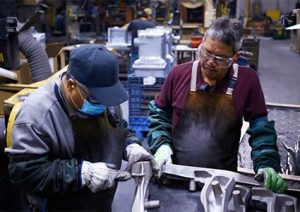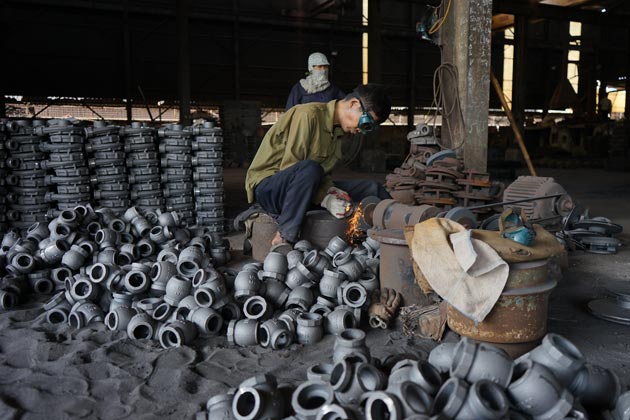How Aluminum Foundry Wisconsin supports casting businesses
Comprehending the Benefits and Innovations in the Aluminum Foundry Industry
The Aluminum Foundry market plays a necessary duty in contemporary manufacturing. Its light-weight residential or commercial properties significantly boost gas efficiency, particularly in automobile and aerospace industries. On top of that, Aluminum's resistance to deterioration warranties longevity in various applications. As the industry develops, advancements such as sophisticated recycling and additive production are improving production techniques. Checking out these improvements exposes not just the benefits but also the challenges ahead for Aluminum foundries in a rapidly transforming market.
The Lightweight Benefit of Aluminum
Aluminum's lightweight nature offers significant advantages throughout numerous markets, especially in manufacturing and transportation. Its reduced thickness enables the production of parts that are easier to set up and deal with, resulting in decreased labor costs and boosted performance. In the vehicle market, lighter automobiles contribute to improved gas economic situation and lower emissions, aligning with international sustainability objectives. In aerospace, the use of Aluminum lowers the total weight of aircraft, which is crucial for enhancing performance and reducing operational costs.
Additionally, Aluminum's light-weight homes promote innovative layouts that were previously impossible with heavier products. This flexibility makes it possible for producers to develop complex shapes and frameworks while maintaining architectural integrity. Generally, the light-weight advantage of Aluminum not just enhances product efficiency but likewise drives advancements in innovation and layout, making it a preferred product in numerous applications.
Deterioration Resistance and Resilience
The Aluminum Foundry sector is renowned for producing materials with remarkable deterioration resistance, making them perfect for numerous applications. This home, integrated with boosted structural integrity, adds to the durable efficiency advantages that Aluminum components offer. Therefore, markets significantly depend on Aluminum to satisfy requiring ecological conditions without compromising quality.
Superior Rust Resistance
While different steels deal with substantial obstacles from ecological factors, Aluminum stands apart for its exceptional rust resistance, making it a favored option in numerous applications. This building is largely as a result of an all-natural oxide layer that bases on the Aluminum surface area, supplying a barrier against moisture and harsh representatives. Unlike various other metals that may rust or break down with time, Aluminum maintains its stability even in severe settings, such as industrial settings or seaside locations. Additionally, its light-weight nature combined with corrosion resistance makes it perfect for applications in aerospace, automobile, and marine sectors. Generally, Aluminum's phenomenal durability not just improves product long life however also lowers upkeep costs, offering a compelling advantage for suppliers and customers alike.
Improved Architectural Stability
Engineers and developers increasingly identify the significance of enhanced architectural integrity in contemporary applications, where both corrosion resistance and durability are essential. Aluminum alloys, understood for their lightweight homes, also display exceptional resistance to deterioration, making them suitable for extreme environments. The ingenious strategies utilized in the Aluminum Foundry market add considerably to creating parts with boosted sturdiness. Advanced casting processes and alloy structures are customized to meet certain efficiency requirements, making sure that frameworks can endure severe problems without endangering stability. Furthermore, surface therapies and finishings enhance the lifespan of Aluminum products, even more alleviating deterioration in time. This focus on enhanced structural stability not just expands the use of products but also reduces maintenance costs, solidifying Aluminum's setting as a product of option in numerous markets.
Durable Efficiency Benefits
Long-lasting performance in Aluminum components is largely associated to their remarkable deterioration resistance and resilience. Unlike numerous metals, Aluminum naturally forms a safety oxide layer, which protects against corrosion and deterioration in various environments, consisting of marine and commercial settings. This inherent residential property substantially prolongs the life expectancy of Aluminum products, decreasing upkeep and substitute costs. Furthermore, the light-weight nature of Aluminum improves its applicability across sectors without endangering stamina. The material's resistance to damage additionally adds to its reliability sought after applications, making it an ideal selection for vehicle, aerospace, and construction sectors. As sectors progressively prioritize sustainability and long life, Aluminum's efficiency benefits align with modern-day engineering needs, strengthening its function in cutting-edge manufacturing procedures.
Environmental Influence and Sustainability
 As the Aluminum Foundry market advances, it increasingly focuses on ecological impact and sustainability, acknowledging the demand for liable practices when faced with climate modification. Efforts to decrease waste and energy usage go to the center, with many foundries embracing reusing campaigns to reclaim Aluminum scrap. This not only decreases resources use yet also notably lowers power expenditure, as recycled Aluminum needs just a portion of the power contrasted image source to key production.
As the Aluminum Foundry market advances, it increasingly focuses on ecological impact and sustainability, acknowledging the demand for liable practices when faced with climate modification. Efforts to decrease waste and energy usage go to the center, with many foundries embracing reusing campaigns to reclaim Aluminum scrap. This not only decreases resources use yet also notably lowers power expenditure, as recycled Aluminum needs just a portion of the power contrasted image source to key production.Furthermore, innovations in exhausts regulate technologies are being executed to decrease air pollutants, lining up operations with stricter environmental policies. Shops are additionally discovering different power sources, such as solar and wind, to power their facilities sustainably. By fostering collaboration with stakeholders, the sector intends to establish ingenious services that enhance ecological stewardship. Jointly, these campaigns highlight a commitment to decreasing the Aluminum Foundry's carbon impact while advertising a round economic climate within the manufacturing industry.
Advanced Production Techniques
 Reinventing production procedures, the Aluminum Foundry market is increasingly incorporating advanced production techniques to boost effectiveness and accuracy. Methods such as computer system numerical control (CNC) machining and additive production have arised as vital parts in enhancing manufacturing process. CNC machining permits for high-precision element manufacture, significantly lowering material waste and manufacturing time. Additive production opens new methods for complex geometries and light-weight layouts that were previously tough to attain.
Reinventing production procedures, the Aluminum Foundry market is increasingly incorporating advanced production techniques to boost effectiveness and accuracy. Methods such as computer system numerical control (CNC) machining and additive production have arised as vital parts in enhancing manufacturing process. CNC machining permits for high-precision element manufacture, significantly lowering material waste and manufacturing time. Additive production opens new methods for complex geometries and light-weight layouts that were previously tough to attain.Furthermore, the release of automation and robotics in Aluminum foundries improves procedures, minimizes human error, and enhances employee safety. These innovations facilitate a more receptive manufacturing environment, enabling makers to adapt rapidly to market needs. The combination of advanced simulation software further enhances the layout and screening stages, resulting in exceptional item quality. Collectively, these methods not only enhance operational effectiveness however likewise foster advancement, placing the Aluminum Foundry sector at the center of modern-day production.
Technologies in Reusing Procedures
The Aluminum Foundry sector is not just advancing in manufacturing strategies however is likewise making significant strides in reusing procedures. Developments are emerging to boost the effectiveness of recycling methods, lowering power consumption and boosting sustainability. Advanced arranging technologies, such as computerized optical sorting, make it possible for the identification and splitting up of Aluminum from various other materials with high accuracy. This results in a better of recycled Aluminum, which is vital for keeping the honesty of the final items.
Additionally, closed-loop recycling systems are being implemented, permitting producers to recycle Aluminum scrap within their own manufacturing procedures. This lessens waste and promotes a round economy. In addition, research right into new recycling methods, such as hydrometallurgical procedures, provides the possibility for recovering Aluminum from complicated waste streams. These innovations not just add to decreasing the carbon impact of the Aluminum Foundry industry however additionally reinforce its financial viability in a progressively eco conscious market.
Applications Throughout Numerous Industries
Many industries are significantly recognizing the adaptability and advantages of Aluminum Foundry products, resulting in extensive applications throughout sectors such as automobile, building, aerospace, and customer products. In the vehicle sector, Aluminum spreadings add to light-weight vehicle designs, enhancing fuel efficiency and performance. Aerospace producers use Aluminum elements for their strength-to-weight ratio, vital for aircraft structures and elements.
In building, Aluminum is favored for its toughness and resistance to deterioration, making it ideal for home window structures, roof covering, and architectural supports. Durable goods additionally take advantage of Aluminum Foundry items, as seen in kitchenware, electronics, and packaging, where light-weight and recyclable materials are important.
The adaptability of Aluminum Foundry techniques allows for intricate layouts and specific requirements, dealing with the varied requirements of these industries. Consequently, Aluminum Foundry items are ending up being important to modern production procedures across various fields.
Future Patterns in Aluminum Foundries
As industries remain to progress, Aluminum factories are poised to welcome a number of key fads that guarantee to enhance performance and sustainability. One famous trend is the raising adoption of electronic modern technologies, including automation and artificial knowledge, which improve procedures and enhance quality assurance. Additionally, the push in the direction of sustainable techniques is leading factories to buy Web Site recycling technologies, substantially reducing waste and energy consumption.
 Another emerging fad is using sophisticated alloys and products, satisfying the growing need for light-weight and resilient components throughout numerous sectors (Aluminum Foundry). The combination of additive production helpful resources strategies is prepared for to revolutionize part style, using modification and lowering lead times.
Another emerging fad is using sophisticated alloys and products, satisfying the growing need for light-weight and resilient components throughout numerous sectors (Aluminum Foundry). The combination of additive production helpful resources strategies is prepared for to revolutionize part style, using modification and lowering lead times.Collaboration with research institutions is likewise expected to drive development, as factories seek to establish new processes and materials. Aluminum Foundry. Collectively, these patterns suggest a transformative future for the Aluminum Foundry market, lining up with wider goals of sustainability and effectiveness
Often Asked Concerns
What Are the Common Costs Connected With Aluminum Foundry Production?
The typical costs related to Aluminum Foundry manufacturing consist of resources, labor, energy, equipment maintenance, and overhead expenditures. These elements collectively influence the general economic investment needed for effective Aluminum casting operations.
Just How Does Aluminum Contrast to Various Other Metals in Strength?
Aluminum, while lighter than many steels, shows excellent strength-to-weight ratios. Compared to steel, Aluminum is much less strong but offers superb deterioration resistance, making it a positive option in applications where weight and resilience are important.
What Safety Actions Are in Place in Aluminum Foundries?
Safety and security procedures in Aluminum factories typically consist of compulsory personal safety devices, ventilation systems to manage fumes, normal devices maintenance, training programs for staff members, and adherence to rigorous safety and security regulations to reduce risks related to liquified metal handling.
Just How Is Quality Assurance Managed in Aluminum Spreading Processes?
Quality control in Aluminum spreading procedures includes rigorous assessments at various phases, including raw product assessment, procedure monitoring, and final product screening. Methods such as analytical process control and non-destructive screening warranty adherence to market criteria.
What Certifications Are Very Important for Aluminum Foundry Providers?
The relevance of certifications for Aluminum Foundry vendors includes ISO 9001 for quality monitoring, ISO 14001 for ecological management, and industry-specific requirements like ASTM and SAE, making certain compliance, security, and integrity in manufacturing processes.
The Aluminum Foundry market plays a crucial role in contemporary production. The Aluminum Foundry sector is renowned for generating materials with remarkable deterioration resistance, making them perfect for different applications. Changing manufacturing processes, the Aluminum Foundry industry is increasingly integrating sophisticated manufacturing methods to boost performance and accuracy. The Aluminum Foundry sector is not just progressing in making strategies yet is also making significant strides in recycling procedures. As sectors proceed to advance, Aluminum shops are positioned to welcome numerous vital fads that assure to boost effectiveness and sustainability.